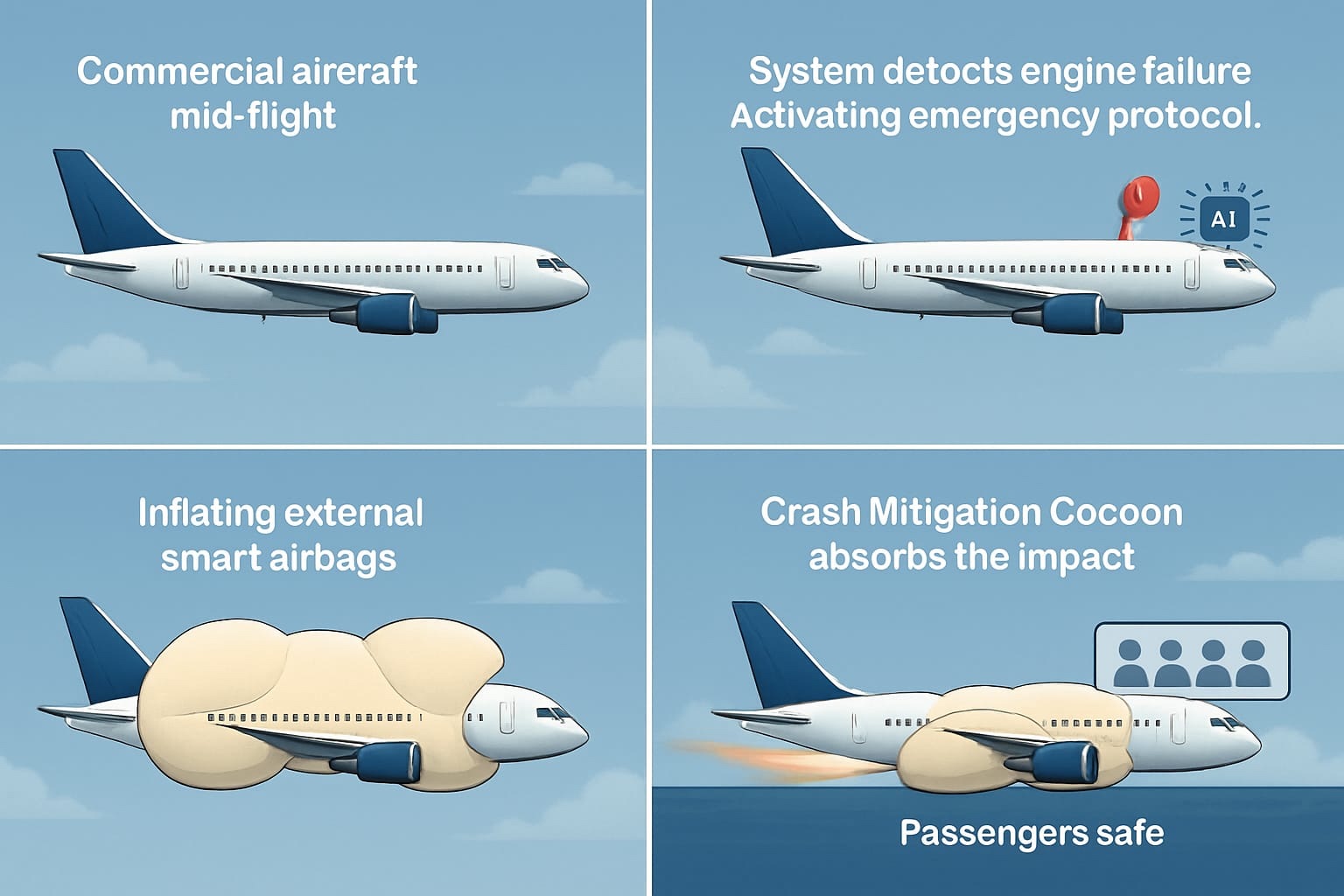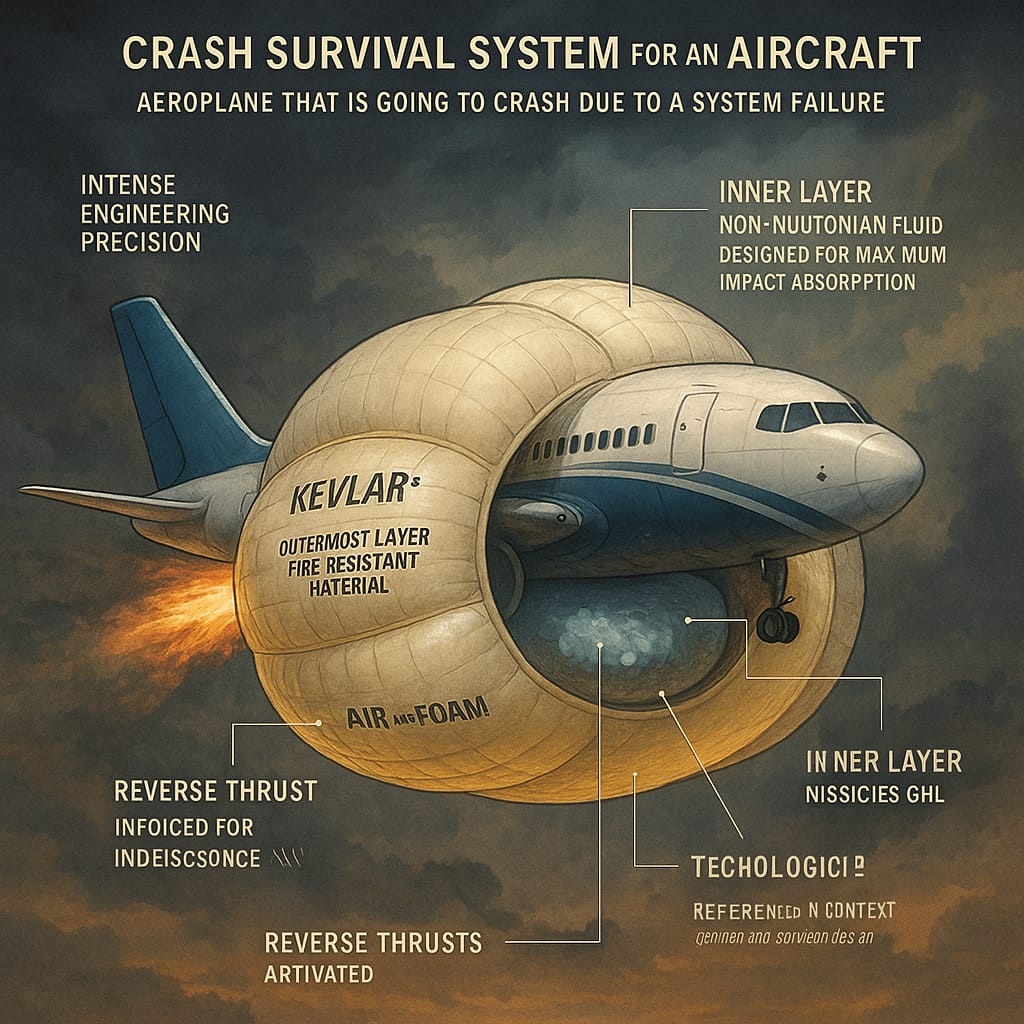An Air India flight from Ahmedabad bound for London spent just 30 seconds in the air before disaster struck earlier this year. Preliminary reports indicate that the aircraft’s fuel control switches were inexplicably turned off shortly after takeoff, cutting fuel to the engines and causing total power loss. Frantic cockpit recordings reveal the two pilots questioning each other in confusion over who made the fatal decision. Amid the chaos, the plane plummeted and crash-landed, killing all but one person on board. It was the deadliest aviation disaster in a decade.
A pair of aviation engineers from the Birla Institute of Technology and Science in India believe they have developed a design that could help prevent similar crashes—a design that involves massive, AI-controlled external airbags. Called Project REBIRTH, the multi-layered safety system would retrofit aircraft with a suite of sensors that constantly monitor flight conditions. If the system determines a crash below 3,000 feet is unavoidable, giant airbags would deploy, forming a protective cocoon designed to absorb impact energy and reduce damage. An infrared beacon and flashing lights would also be activated during the crash with the goal of making the cushioned wreckage easier for emergency responders to locate.

The engineers are calling their design, which is nominated for 2025 James Dyson Award, the world’s first “AI-powered crash survival system.” Though still in its early testing phases, they say computer simulations show the system can reduce crash forces by more than 60 percent. In theory, a softer landing, combined with faster, AI-driven emergency response decisions, could mean the difference between passengers surviving or dying in a crash. An aviation expert speaking with Popular Science said the concept shows promise but cautioned that many unanswered questions remain, particularly regarding the added weight of the airbags.
“This sounds like an interesting idea BUT airline disasters that this airbag system is intended to mitigate would mean that future aircraft would all be carrying the additional weight and other compromises to mitigate one accident in 20 years,” Jeff Edwards, a retired US Navy 1-6 Intruder bombardier and founder of aviation safety consulting firm AVSafe, told Popular Science.
REBIRTH emerged as a “response to grief”
Eshel Wasim and Dharsan Srinivasan, the brains behind REBIRTH, say the concept was a direct response to the Air India crash, which left them and their family members reeling.
“My mother couldn’t sleep,” Wasim writes. “She kept thinking about the fear the passengers and pilots must have felt, knowing there was no way out. That helplessness haunted us.”
The pair began scouring academic research on airline safety measures and discovered a notable gap. Most air safety systems are designed to prevent crashes, with comparatively little focus on improving survivability when a crash is unavoidable. With that in mind, they set out to develop a method targeting three specific goals: slowing an aircraft before impact, absorbing the force of the crash, and helping rescuers locate and respond to the site more quickly.
“REBIRTH is more than engineering—it’s a response to grief,” the engineers write. “A promise that survival can be planned, and that even after failure, there can be a second chance.”
Using AI, giant airbags, and reverse thrusters to make crashes safer
REBIRTH, as a system, begins working long before the popcorn-shaped airbags deploy. Sensors distributed throughout the aircraft monitor altitude, speed, engine status, direction, and pilot response. These sensors relay data to an onboard AI system, which analyzes the information to determine whether a crash appears imminent. If the system makes that determination at or below 3,000 feet, it triggers airbag deployment. The engineers note that pilots have a brief window to override the AI’s deployment decision, though it’s unclear exactly how long that window lasts.
If a pilot override doesn’t occur, massive airbags deploy from the nose, belly, and tail of the aircraft. All of that should happen in under two seconds. The so-called “smart airbags” are constructed from layers of Kevlar, TPU, Zylon, and STF, materials specifically selected for their energy-absorbing properties. These fabric layers are reinforced by an inner lining of various “non-Newtonian fluids” (liquids that don’t have a constant viscosity), which help further absorb impact. Assuming the engines are still functional, they will also automatically engage in reverse thrust to help slow the aircraft. According to the engineers, this reverse thrust alone could reduce the plane’s speed before impact by anywhere from 8 to 20 percent.
Once the airbag covered plane makes impact, the system would then automatically shoot out infrared beacon, GPS coordinates, and lights to help first responders quickly identify it.
“It prepares for the worst when all else fails,” the engineers write.
So far, Wasim and Srinivasan say they’ve seen promising results from computer simulations of their system. They have also built a 1:12 scale prototype and have begun reaching out to policymakers, aircraft manufacturers, and government agencies to initiate larger-scale, real-world testing. In theory, they believe the system could be retrofitted onto various types of aircraft, both new and old.
“Today, REBIRTH is ready for scaled testing, with schematics, simulations, and materials data prepared,” they write.

Overly heavy airbags could do might do more harm than good
Edwards, the aviation expert from AVSafe, said more testing data is needed before the viability of the airbag system can be determined. The system’s actual effectiveness, he noted, may partly depend on its overall weight. Although the airbags and thrusters are intended to reduce the force of impact, that benefit could be offset if the system is so heavy that it adds significant weight and drag. The airbags themselves would also need to be enormous to meaningfully reduce the impact forces of a commercial aircraft weighing over 600,000 pounds.
“The weight penalty alone would be a major concern,” Edwards said.
There’s also still some uncertainty about the overall effectiveness of the AI monitoring system as proposed. While AI could sense the plane’s proximity to the ground and make a decision to deploy safety measures, Edwards said there are still many other real-time variables that need to be factored in when making an off-airport landing.
Parachutes, ‘magic skin’ and trap door: the whacky world of plane safety ideas
REBIRTH follows a long line of eye-catchingly ambitious air safety proposals, many of which never end up seeing the light of day. Some smaller twin-engine planes are already capable of deploying large “whole airplane” parachutes designed to help an aircraft descend safely in the event of engine failure. Back in 2011, researchers backed by NASA funding explored the development of so-called self-healing “magic skin” for aircraft that could shield the exterior from lightning, extreme temperatures, and electromagnetic interference. The process involved coating planes with a conductive film and energy-absorbing foam. They also explored ways for the coating to repair itself if punctured or torn.
Other proposed safety measures have been notably less high-tech. Following the September 11 terrorist attacks, Airbus filed a patent for a trapdoor installed at the cockpit entrance, apparently designed to eject a would-be attacker from the aircraft midair. The same patent even proposed deploying tranquilizer gas in the cabin as an anti-terrorism measure. As far as we can tell, neither of these concepts ever made it into commercial aircraft.
If REBIRTH does end up winning the Dyson award when it’s announced on November 5, it will join a cadre of out-of-the-box proposals. Past winners of the award include a team that created an off-road trailer used to transport wounded soldiers in Ukraine, a biomedical wearable glove used to test for glaucoma, and an “E-coating” made of waste glass used to reduce the heat absorption of buildings. Winners of the award receive $40,000 in prize money.






